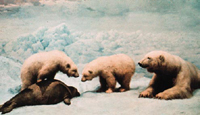 An international team of 300 scientists, other experts, and elders have prepared “Impacts of a Warming Arctic,” a comprehensive analysis of the impacts and consequences of climate variability and changes across the Arctic, including the impacts from increases in UV radiation due to depletion of the ozone layer in the north.
An international team of 300 scientists, other experts, and elders have prepared “Impacts of a Warming Arctic,” a comprehensive analysis of the impacts and consequences of climate variability and changes across the Arctic, including the impacts from increases in UV radiation due to depletion of the ozone layer in the north.
Dr. Robert W. Corell, Chair of the Arctic Climate Impact Assessment, summarized the findings:
“The Arctic is now experiencing some of the most rapid and severe climate change on Earth. Over the next 100 years, climate change is expected to accelerate, contributing to major physical, ecological, social, and economic changes, many of which have already begun. Changes in arctic climate will also affect the rest of the world through increased global warming and rising sea levels.
“These climate changes are being experienced particularly intensely in the Arctic. Arctic average temperature has risen at almost twice the rate as the rest of the world in the past few decades. Widespread melting of glaciers and sea ice and rising permafrost temperatures present additional evidence of strong arctic warming.”
Predicted changes include: A further warming of 4-7 degrees Celcius following on the last 50 years warming of 3-4 degrees C; Possible complete melting of the Greenland Ice Sheet with subsequent ocean rise of 27 metres; and probable extinction of polar bears and seals
The full report can be read at http://www.acia.uaf.edu/ A free summary brochure is also available.
Human Rights
The Inuit of the world’s Arctic, along with other poor and threatened peoples, say that the dangers they face through climate change are a human rights issue. The Inuit are seeking a ruling from the Inter-American Commission on Human Rights that the United States, by contributing substantially to global warming, is threatening their existence. The ruling would have no legal force but would create a precedence for later legal action.
—New York Times, December 2004
New tools to reduce our share of climate change
A.couple of easy-to-use tools provide practical things to do to help protect nature and reduce our impacts on climate change.
One Tonne Challenge, developed by the federal government of Canada, is available at http://www.climatechange.gc.ca/onetonne/english/ . There is a calculator to estimate and keep track of our greenhouse gas emissions. A Tips Guide identifies new actions you can take to reduce your greenhouse gas emissions. Many of the tips will help you save money, improve air quality and protect our environment.
The Nature Challenge from the David Suzuki Foundation, available at http://www.davidsuzuki.org/WOL/Challenge, describes the “10 most effective ways to help conserve nature and improve our quality of life,” including: reduction of home energy use by 10%; choice of an energy-efficient home, appliances and vehicles; meat-free meals one day a week; purchase of locally grown and produced food; and more. If we all work together, we can limit the extent of climate change. These tools can help.
***
[From WS January/February 2005]